Introduction
The First Edition of this catalogue, then named the "Commonwealth Specialists' Catalogue", was issued in 1926.
In 1953, under a new publisher and editor, it was renamed the "Australian Commonwealth Specialists' Catalogue".
In 1987 the catalogue was acquired by Brusden-White, who released a loose-leaf edition in 1988.
In 1992, with Brusden-White under new ownership and with new editors, the decision was made to rewrite the catalogue and progressively issue it in separate volumes.
The first volume released was the 'Kangaroos' in 1993.
In 2018 the first of the full-colour A4 size volumes was released with the final volume in this new
format being released in 2022.
The Australian Commonwealth Specialists' Catalogue is still in production and continues to evolve with each new edition.
It covers the period from Early Federation until the end of 2001 .
Forerunner to the ACSC Catalogue
The Stamps of the Commonwealth of Australia by Alec A. Rosenblum
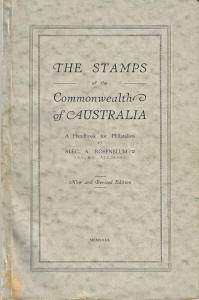 The introduction to Orlo-Smith's First Edition of the Commonwealth Specialists' Catalogue included the following statement:
The introduction to Orlo-Smith's First Edition of the Commonwealth Specialists' Catalogue included the following statement:
"The thanks of the publishers are due to Mr. A. A. Rosenblum, for his valuable assistance in the compiling the lists and for information
taken from his book, Stamps of the Commonwealth of Australia;...."
Alec Rosenblum's publication is not a stamp catalogue as such but
is a handbook, acknowledged in its time as a standard work on the stamps of the Commonwealth of Australia.
The 1926 publication includes an appendix titled "Check List of Prominent Varieties of Commonwealth
Stamps". Editions were released in 1922, 1926, 1928, 1936, 1948, 1966, and 1968.
Alec A. Rosenblum (1895-1973) was well known on the Australian philatelic scene in the 1920s and 1930s.
He served as editor of the Australian Philatelic Record and the Australian Stamp Monthly, and was
significantly involved in research of the Kangaroo and King George V stamps.
He was also a member of the 1932 Committee set up to develop a workable shade listing for the 1d. KGV Heads.
The committee included Colenso Blogg (who compiled the comprehensive 1930 "Z" prefix list) together with Orlo-Smith and others.
The Editions
1926 to 1952 Releases
Stanley Orlo-Smith

 Fourteen editions, numbered 1 to 14, were released between 1926 and 1952.
These editions were titled "The Commonwealth Specialists' Catalogue" and were published by Orlo-Smith & Co., and edited by Stanley Orlo-Smith until his death in 1946.
Fourteen editions, numbered 1 to 14, were released between 1926 and 1952.
These editions were titled "The Commonwealth Specialists' Catalogue" and were published by Orlo-Smith & Co., and edited by Stanley Orlo-Smith until his death in 1946.
They feature two different catalogue cover styles. Editions 1 to 3 plus the supplement, were printed in cursive
italic text; the remainder are in standard sans-script text. Both cover styles are shown above.
The First Edition, released in September 1926, was dated "1926-7".
The Second Edition, released in September 1928, was dated "1928-9".
A Supplement to the 1932 Third Edition was released in July, 1933.
1953 to 1955 Releases
C. E. (Eric) Norden
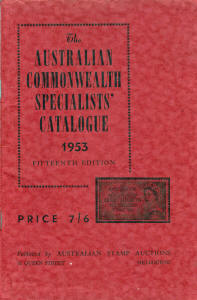
 Two editions, numbered 15 & 16, were edited by Mr. C. E. (Eric) Norden. Two editions, numbered 15 & 16, were edited by Mr. C. E. (Eric) Norden.
It was was the first to be issued with the title "Australian Commonwealth Specialists' Catalogue", and was the first to list the 1d. KGV Reds as a separate section.
The 15th Edition (1953) was published by Australian Stamp Auctions and printed by Hawthorn Press.
The 16th Edition (1955) was published and printed by The Hawthorn Press.
1956 to 1964 Releases
Rev. J. C. W. Brown

 Nine editions, numbered 17 to 25, were published by The Hawthorn Press and edited by Rev. J. C. W. Brown. Nine editions, numbered 17 to 25, were published by The Hawthorn Press and edited by Rev. J. C. W. Brown.
The 18th Edition (1957) saw significant changes to the KGV 1d. Red shade names, together with
the deletion of some existing shades and the addition of some new shades.
The 25th Edition (1964) celebrated the 25th Anniversary with a silver text printed cover.
The first and last editions are shown here.
1965 to 1980 Releases
John Meara

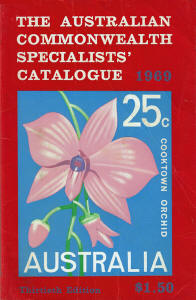
 Fifteen editions, numbered 26 to 40, were published by The Hawthorn Press and edited by Mr. John Percival Meara. Fifteen editions, numbered 26 to 40, were published by The Hawthorn Press and edited by Mr. John Percival Meara.
The 30th Edition (1969) was the first to abandon the traditional red stapled cover for a coloured softbound cover.
1981 to 1983 Releases
John Meara

 Two editions, numbered 41 and 42, were published by Seven Seas Stamps and edited by Mr. John Percival Meara.
Two editions, numbered 41 and 42, were published by Seven Seas Stamps and edited by Mr. John Percival Meara.
The 41st Edition was published in 1981 and was the first to be printed in full
colour, however it arguably suffered from a drastic reduction of the number of listed shades and the
deletion of the KGV "G" numbering system.
The 42nd Edition was published in 1983. It also was in full colour and was the first
edition with a hard-cover.
Editorially it reversed some of the previous deletions (including the deletion of the "G" prefix numbers) due to: "...the radical generalised treatment of certain content in the 1981 edition
which drew some adverse comment".
1988 Releases
Alan J. White
A fully revised and expanded edition was published by Brusden-White in 1988, and was compiled and edited by Alan J. White.
Chronologically this release represents the 43rd edition of the ACSC series, and is the last of the single edition catalogues.
It was available as a A5 loose-leaf binder and as a A5 bound book.



 The Loose-Leaf Edition was printed in colour, with a special
four-ring binder to accommodate future updates (available by subscription).
The Loose-Leaf Edition was printed in colour, with a special
four-ring binder to accommodate future updates (available by subscription).
A second binder (to house the decimal section) came latter, as the number of pages grew.
All pages (including the updates) were dated, numbered, and designated as either permanent or temporary.
 The Loose-Leaf Edition Updates
are known
to have been issued in 1989, 1990, 1992, 1994, 1995, 1997.
The Loose-Leaf Edition Updates
are known
to have been issued in 1989, 1990, 1992, 1994, 1995, 1997.
The 1989 update included pages for Sections: D, H, I, J, K, N, W, X, Y, Z, AAT.
The 1990
update included a totally new Section A "Australian States" from 1850 to 1910; together with updates to sections: N,
V, W, X, Y.
The 1992
update included two new sections: AA "Pre-Decimal Postage Rates" & Va "Stamped Labels", together with updates to Sections: N, O, V, W, X, AAT.
The 1994
update included a new section Vb "Counter-Printed Stamps", together with
updates to Sections: N, O, V, W.
The 1995
update included a new section Vc "Automatic Teller Machine Stamps", together with
updates to Sections: N, O, V, Va, Vb, W, AAT.
The 1997
update included updates to Sections: N, O, V, Vb, Vc, W.
 The Bound Version of the loose-leaf edition was also published.
It is an A5 hard-cover bound book containing colour pages identical to the loose-leaf edition.
The Bound Version of the loose-leaf edition was also published.
It is an A5 hard-cover bound book containing colour pages identical to the loose-leaf edition.
It contains only the 1988 dated permanent and temporary pages.
1990 Release
Alan J. White
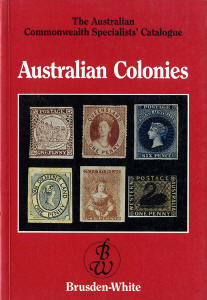 A separate Australian Colonies booklet was published in 1990 by Brusden-White.
It was compiled by Harry L. Bazelmans and edited by Alan J. White.
A separate Australian Colonies booklet was published in 1990 by Brusden-White.
It was compiled by Harry L. Bazelmans and edited by Alan J. White.
This publication is printed in colour and covers the period from 1850 to 1910, including Postage Due stamps.
It is a A5 size, 90 page (some pages blank for notes) bound booklet comprising Section A
which was not included in the 1988 release, but was part of the 1990 loose-leaf update.
1992 Changes
Geoffrey Kellow
Following a change of ownership of ACSC and the appointment of Dr. Geoffrey Kellow as Editor,
the decision was made to release future editions of the New Brusden-White's Australian Commonwealth Specialists' Catalogue in separate volumes, as follows:
Kangaroos
King George V
King George VI
Queen Elizabeth II 1952-1966
Decimals I 1966-1975
Decimals II 1975-1991
Decimals III 1992-2001
Postage Dues
Booklets
Postal Stationary
1993 New Loose-Leaf Format
Geoffrey Kellow & Richard Breckon

 A new Loose-Leaf format was released; similar to the 1988 Edition, except that the pages are approximately 27mm wider (identical in width of the
new single edition catalogues). These updates are not related to the (narrower) updates issued for the 1988 Interim Loose-Leaf edition.
A new Loose-Leaf format was released; similar to the 1988 Edition, except that the pages are approximately 27mm wider (identical in width of the
new single edition catalogues). These updates are not related to the (narrower) updates issued for the 1988 Interim Loose-Leaf edition.
On the cover page (above), the editors are listed as Geoffrey Kellow & Richard Breckon, however it is
believed that from c1995 the editor is Geoffrey Kellow.
The pages are consecutively numbered and there are no "permanent" or "temporary" page designations. The images are not in colour.
The following wide-format loose-leaf releases were issued:
1993 - Introduction; The Early Federal Period (1901-1912); Kangaroo Series (1913-1950).
1994 - The Engraved Definitives (1913-1914); KGV Head Series (1914-1938); Other KGV Issues (1927-1936).
1995 - King George VI Issues (1937-1952); B.C.O.F (1946-1949); Booklets (1904-1973).
1996 - Queen Elizabeth II issues (1952-1966).

 It is not known when Brusden-White officially discontinued the loose-leaf releases,
however new loose-leaf binders and current catalogues pages are still available from a third party. See here:
Link
It is not known when Brusden-White officially discontinued the loose-leaf releases,
however new loose-leaf binders and current catalogues pages are still available from a third party. See here:
Link
NEW BRUSDEN-WHITE SINGLE VOLUME CATALOGUES
Dr. Geoffrey (Geoff) Kellow
1993 Release
 The First Edition of ACSC Kangaroos was published in 1993 by Brusden-White, as Sections 1 & 2 of the new
Australian Commonwealth Specialists' Catalogue. It was based on the 1993 update of the 1993 loose-leaf edition.
The First Edition of ACSC Kangaroos was published in 1993 by Brusden-White, as Sections 1 & 2 of the new
Australian Commonwealth Specialists' Catalogue. It was based on the 1993 update of the 1993 loose-leaf edition.
Section 1 covers "The Early Federal Period, 1901-1912", comprising stamp essays and designs. Section 2 covers "The Kangaroo and Map Series, 1913-1950".
This publication is a A5+ softbound book, comprising 124 pages with black and white images.
1994 Release
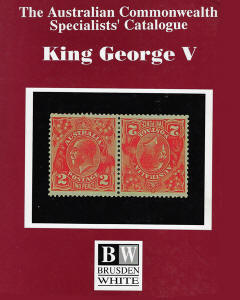 The First Edition of ACSC King George V was published in 1994 by Brusden-White, as Sections 3, 4, & 5 of the new
Australian Commonwealth Specialists' Catalogue. It was based on the 1994 update of the 1993 loose-leaf edition.
The First Edition of ACSC King George V was published in 1994 by Brusden-White, as Sections 3, 4, & 5 of the new
Australian Commonwealth Specialists' Catalogue. It was based on the 1994 update of the 1993 loose-leaf edition.
Section 3 covers The Engraved Definitives of 1913-1914. Section 4 covers The King George V Head Series, 1914-1938.
Section 5 covers The Other King George V Issues, 1927-1936.
This publication is a A5+ softbound book, comprising 326 pages with black and white images.
1995 Releases
Two new catalogues were issued this year.
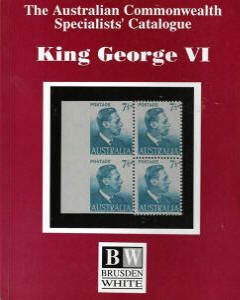 The
First Edition of ACSC King George VI was published in 1995, as Sections 6 &7 of the new Brusden-White catalogue
and is based on the 1995 update of the 1993 loose-leaf edition. The
First Edition of ACSC King George VI was published in 1995, as Sections 6 &7 of the new Brusden-White catalogue
and is based on the 1995 update of the 1993 loose-leaf edition.
Section 6 covers The King George VI Issues, 1937-1952. Section 7 covers British Commonwealth Occupation Forces in Japan, 1946-1949.
This publication is a A5+ softbound book, containing 223 black & white pages.
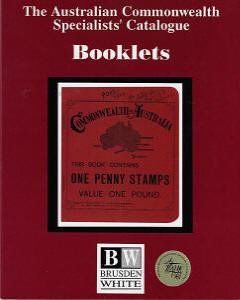 The
First Edition of ACSC Booklets was also published in 1995, as Section 11 of the new Brusden-White catalogue.
It is based on the 1995 update of the 1993 loose-leaf edition. The
First Edition of ACSC Booklets was also published in 1995, as Section 11 of the new Brusden-White catalogue.
It is based on the 1995 update of the 1993 loose-leaf edition.
This edition embraces all stamp booklets issued by the Commonwealth of Australia from their introduction in 1904 up to
their temporary discontinuation in 1973. It also includes booklets containing Australia State stamps from 1904 to 1912.
This publication is a A5+ softbound book, comprising 133 black & white pages.
1996 Releases
One revised catalogue and one new catalogue were issued this year.
 The Second Edition of ACSC Kangaroos was published in 1996 by Brusden-White. The
previous edition was released in 1993.
The Second Edition of ACSC Kangaroos was published in 1996 by Brusden-White. The
previous edition was released in 1993.
This publication is a A5+ softbound book, comprising 125 pages with black and white images.
 The First Edition of ACSC Queen Elizabeth II 1952-1966 was published in 1996, as Section 8 of the New Brusden-White Catalogue.
The First Edition of ACSC Queen Elizabeth II 1952-1966 was published in 1996, as Section 8 of the New Brusden-White Catalogue.
This section covers the pre-decimal stamps issued during the reign of Queen Elizabeth II.
This publication is an A5+ softbound book, comprising 264+ pages with black and white images.
1997 Release
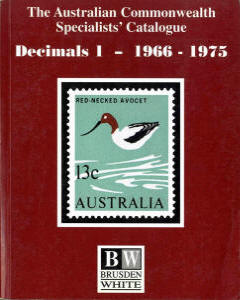 The
First Edition of ACSC Decimals I - 1966-1975 was published in 1997, as Section 9 of the New Brusden-White Catalogue.
It is based on the 1997 update of the 1988 loose-leaf edition. The
First Edition of ACSC Decimals I - 1966-1975 was published in 1997, as Section 9 of the New Brusden-White Catalogue.
It is based on the 1997 update of the 1988 loose-leaf edition.
This volume covers all stamps issued under the authority of the Postmaster-General's department, from the introduction of Decimal
Currency on 14 February 1966 up to 1st July 1975, when the Australia Postal Commission was established.
This publication is an A5+ softbound book, comprising 379 pages with black and white images.
1999 Releases
One revised catalogue and one new catalogue were issued this year.
 The
Third Edition of ACSC Kangaroos was published in 1999 by Brusden-White.
Previous editions were released in 1993 and 1996. The
Third Edition of ACSC Kangaroos was published in 1999 by Brusden-White.
Previous editions were released in 1993 and 1996.
This publication is a A5+ softbound book,
comprising 144 pages with black and white images.
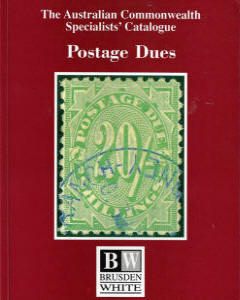 The
First Edition of ACSC Postage Dues, was published in 1999, as Section 10 of the New Brusden-White Catalogue.
This new section is based on the 1999 update to the 1988 loose-leaf edition. The
First Edition of ACSC Postage Dues, was published in 1999, as Section 10 of the New Brusden-White Catalogue.
This new section is based on the 1999 update to the 1988 loose-leaf edition.
The publication is an A5+ softbound book, comprising 138 pages with black and white images.
2001 Release
 The Second Edition of ACSC King George V was published in 2001 by Brusden-White.
The previous edition was released in 1994.
The Second Edition of ACSC King George V was published in 2001 by Brusden-White.
The previous edition was released in 1994.
This publication is a A5+ softbound book, comprising 383 pages with black and white images.
This edition marks the beginning of a program to replace plate variety drawings with scanned images of actual stamps.
Based on recent research, the quantities of stamps printed have been added or revised where necessary.
2002 Releases
One revised catalogue and two new catalogues were issued this year.
 The Second Edition of ACSC Decimals I (1966-1975) was published in 2002,
and was renumbered as Section 9A. It was previously numbered as section 9.
The Second Edition of ACSC Decimals I (1966-1975) was published in 2002,
and was renumbered as Section 9A. It was previously numbered as section 9.
This publication is an A5+ softbound book, comprising 436 pages with black and white images.
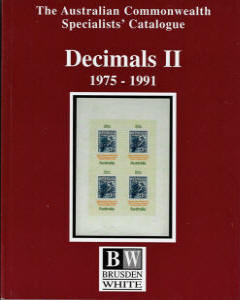 The First Edition of ACSC Decimals II (1975-1991) was published in 2002, as Section 9B of the New Brusden-White Catalogue.
The First Edition of ACSC Decimals II (1975-1991) was published in 2002, as Section 9B of the New Brusden-White Catalogue.
Section 9B covers the period from 1st July 1975 to Christmas 1991.
This publication is an A5+ softbound book, comprising 558 pages with black and white images.
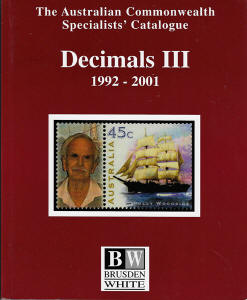 The First Edition of ACSC Decimals III (1992-2001) was published in 2002, as Section 9C of the New Brusden-White Catalogue.
The First Edition of ACSC Decimals III (1992-2001) was published in 2002, as Section 9C of the New Brusden-White Catalogue.
Section 9C covers the period from 2nd January 1992 to Christmas 2001, and represents completion of the period of 100 years since Federation.
This publication is an A5+ softbound book, comprising 512 pages with black and white images.
2003 Release
 The Second Edition of ACSC Booklets was published in 2003. The previous edition
was released in 1995.
The Second Edition of ACSC Booklets was published in 2003. The previous edition
was released in 1995.
This edition now embraces stamp booklets issued by the Commonwealth of Australia from their introduction in 1904 up to the the end of 2001.
This publication was a A5+ softbound book, comprising 261 pages with black and white images.
2004 Release
 The Fourth Edition of ACSC Kangaroos was published in 2004 by Brusden-White.
Previous editions were released in 1993, 1966, and 1999.
The Fourth Edition of ACSC Kangaroos was published in 2004 by Brusden-White.
Previous editions were released in 1993, 1966, and 1999.
Section 1 of this edition included Australian State stamps issue under the authority of
the Commonwealth Postmaster-General's Department between 1901 and 1912. This was the only edition to include the State stamps.
This publication is a A5+ softbound book, comprising 547 pages with black and white images. This includes 373 pages of the newly included State stamps.
2006 Releases
Two revised catalogues were issued this year.
 The Second Edition of ACSC King George VI was released in 2006. The first edition
was released in 1995.
The Second Edition of ACSC King George VI was released in 2006. The first edition
was released in 1995.
This publication is a A5+ softbound book, containing 261 pages with black and white images.
 The
Second Edition of ACSC Queen Elizabeth II (1952-1966) was
released in 2006. The first edition was released in 1996. The
Second Edition of ACSC Queen Elizabeth II (1952-1966) was
released in 2006. The first edition was released in 1996.
This publication is an A5+ softbound book, comprising 355 pages with black and white images.
This edition is essentially unchanged except for a number of new plate varieties, revised the plate numbers and new enlarged illustrations.
A number of new shades, together with corrections and additions of the printing quantities of each stamp have been added.
Two new sections have been added to this edition. Sections 8A covers stamps of the Australian Antarctic Territory, and section 8B
covers stamps of the Cocos (Keeling) Islands.
2007 Release
 The Third Edition of ACSC King George V was published in 2007 by Brusden-White.
Previous editions were released in 1994 and 2001.
The Third Edition of ACSC King George V was published in 2007 by Brusden-White.
Previous editions were released in 1994 and 2001.
This publication is a A5+ softbound book, comprising 401 pages with black and white images.
2013 Releases
One revised catalogue and one new catalogue were issued this year.
 The
Fifth Edition of ACSC Kangaroos was published in 2013 by Brusden-White.
Previous editions were released in 1993, 1966, 1999, and 2004. The
Fifth Edition of ACSC Kangaroos was published in 2013 by Brusden-White.
Previous editions were released in 1993, 1966, 1999, and 2004.
This edition celebrated the "Centenary of the First Kangaroo Stamps, 1913-2013".
This edition was released in two forms. A standard A5+ softbound book comprising 324 pages with black and white
images; and
a same size Full Colour Deluxe
Hardbound Edition limited to 100 numbered copies.
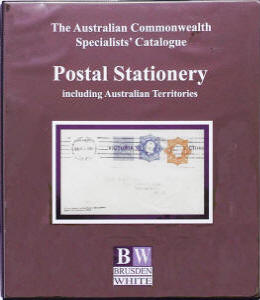 The
First Edition of ACSC Postal Stationery was published in 2013, as Section 12 of the New Brusden-White Catalogue. The
First Edition of ACSC Postal Stationery was published in 2013, as Section 12 of the New Brusden-White Catalogue.
This edition covers the period 1911 to 1980, and includes the Australian Territories of: Christmas island, New Guinea, Papua, and Papua and New Guinea.
This publication comprises a 4 ring binder with A4 loose-leaf pages
(with tabs). It contains 419 pages with colour images.
2014 Releases
Two revised catalogues were issued this year.
 The
Fourth Edition of ACSC King George V
was published in 2014 by Brusden-White. Previous editions were released in 1994, 2001, and 2007. The
Fourth Edition of ACSC King George V
was published in 2014 by Brusden-White. Previous editions were released in 1994, 2001, and 2007.
This edition celebrates the "Centenary of the King George V
Definitives, 1914-2014".
This publication is a A5+ softbound book, comprising
463 pages with black and white images.
 The
Second Edition of ACSC Postage Dues was published in 2014. The first edition
was released in 1999. The
Second Edition of ACSC Postage Dues was published in 2014. The first edition
was released in 1999.
This edition includes a specialised listing of the Colonial issues, fully revised Commonwealth
issues, UPU Specimens, and cancelled-to-order stamps.
This publication is a softbound A5+ sized book, comprising 228
pages with black and white images.
2015 Releases
Two revised catalogues were issued this year.
 The
Third Edition of ACSC King George VI was
released in 2015.
Previous editions were released in 1995 and 2006. The
Third Edition of ACSC King George VI was
released in 2015.
Previous editions were released in 1995 and 2006.
Apart from additions to Plate variations, a number of new thin paper
varieties from the 1949-51 period have been added, and some new
shades have been identified and listed.
This publication is a A5+ softbound book, containing 278
pages with black and white images.
 The
Third Edition of ACSC Queen Elizabeth II (1952-1966) was
released in 2015. It covers pre-decimal stamps issued during
the reign of Queen Elizabeth II. Previous editions were
released in 1996 and 2006. The
Third Edition of ACSC Queen Elizabeth II (1952-1966) was
released in 2015. It covers pre-decimal stamps issued during
the reign of Queen Elizabeth II. Previous editions were
released in 1996 and 2006.
The publication is an A5+ softbound book, comprising 374 pages with
black and white images.
2017 Release
 The Sixth Edition of ACSC Kangaroos was published in 2017 by Brusden-White.
The Sixth Edition of ACSC Kangaroos was published in 2017 by Brusden-White.
Previous editions were released in 1993, 1996, 1999, 2004, and 2013.
This is the first Kangaroos to be printed in full colour, including essays and proofs,
and has been revised with new
discoveries. It includes further research on the plate varieties with new plate positions identified, and new varieties added.
This publication is a A5+ softbound book, comprising 229 pages with colour images.
2018 Releases
Two revised catalogues were issued this year.
 The Fifth Edition of ACSC King George V was published in 2018 by Brusden-White.
Previous editions were released in 1994, 2001, 2007, and 2014.
The Fifth Edition of ACSC King George V was published in 2018 by Brusden-White.
Previous editions were released in 1994, 2001, 2007, and 2014.
This is the first KGV to be printed in full colour. It includes a number of new discoveries and plate varieties
added, especially in the ½d, 3d, and 4d values. Prices have been fully revised.
This publication is a A5+ softbound book, comprising 474 pages with colour images.
 The Second Edition of ACSC Postal Stationery
was published in 2018. The first edition was released
in 2013.
The Second Edition of ACSC Postal Stationery
was published in 2018. The first edition was released
in 2013.
This edition adds Australian Territories issues
and is highly specialised with much new and previously unrecorded information.
This edition is a A4 softbound book, printed in colour. It contains 484 pages.
2019 Releases
This year saw the release of new editions of the King George VI and the Queen Elizabeth II Pre-decimal catalogues; now in full colour and in a larger A4 format.
 The Fourth Edition of ACSC King George VI was published in 2019.
Previous editions were released in 1995, 2006, and 2015.
The Fourth Edition of ACSC King George VI was published in 2019.
Previous editions were released in 1995, 2006, and 2015.
This edition is now in full colour, fully revised and incorporating new illustrations, and including Postage Due and BCOF issues.
This publication is a A4 softbound book, containing 232 pages with colour images.
 The Fourth Edition of ACSC Queen Elizabeth II (1952-1966) was published in 2019. Previous editions were released in 1996, 2006, and 2015.
The Fourth Edition of ACSC Queen Elizabeth II (1952-1966) was published in 2019. Previous editions were released in 1996, 2006, and 2015.
This edition is now in full colour, fully revised and incorporating new illustrations, and including Postage Due, Australian Antarctic
Territory and Cocos (Keeling) Island issues.
This publication is a A4 softbound book, containing 276 pages with colour images.
2020 Releases
This year saw the release of new editions of the Postage Dues and the Booklets catalogues; now in full
colour and in a larger A4 format.
 The Third Edition of Postage Dues
(including New South Wales and Victoria) was published in 2020.
Previous editions were released in 1999 and 2014.
The Third Edition of Postage Dues
(including New South Wales and Victoria) was published in 2020.
Previous editions were released in 1999 and 2014.
This catalogue is now an a A4 softbound book containing 160 pages with colour images. It is fully revised with additional illustrations.
It includes specialised listing of the Colonial issues, the Commonwealth issues, UPU Specimen, and cancelled-to-order stamps.
 The
Third Edition of ACSC Booklets was published this year. Previous editions were released in 1995 and 2003. The
Third Edition of ACSC Booklets was published this year. Previous editions were released in 1995 and 2003.
This edition covers booklets issued from 1904 to 2001, with 190 A4 pages with colour images. The listings
have been fully revised with some additions and corrections, with additional illustrations, and prices have
been adjusted to accord with the current market. Some minor changes to Booklet Numbers has been
undertaken.
2021 Releases
This year saw the release of two more editions of The Australian Commonwealth Specialists' Catalogue in the larger full colour
A4 format.
 The
Seventh Edition of ACSC Kangaroos was published this year.
Previous editions were issued in 1993, 1996, 1999, 2004, 2013, & 2017. The
Seventh Edition of ACSC Kangaroos was published this year.
Previous editions were issued in 1993, 1996, 1999, 2004, 2013, & 2017.
This new edition updates the previous 2017 edition, and is in the new full colour A4 format. The Kangaroos listings have been fully revised with
corrections and additions, including a number of new listings added to the pre-1913 essays, and many additional illustrations.
It contains 162 pages.
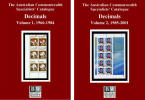 The
Third Edition of ACSC Decimals was published this year.
Previous editions were issued in 1997 & 2002. The
Third Edition of ACSC Decimals was published this year.
Previous editions were issued in 1997 & 2002.
This new two-volume edition covers all Decimal issues up to the end of 2001, and is a complete revision of
the 2002 editions in the new A4 format. A large number of new listings have been included taking account of
the many new items which have surfaced in the last 20 years, and hundreds of new illustrations are
provided.
Volume 1 contains pages 1 to 554, and Volume 2 contains pages 555 to 1147.
2022 Releases
This year saw the final release of The Australian Commonwealth Specialists' Catalogue in the larger full colour
A4 format.
 The Sixth Edition of ACSC KGV was published this year. Previous editions were
issued in 1994, 2001, 2007, 2014, and 2018.
The Sixth Edition of ACSC KGV was published this year. Previous editions were
issued in 1994, 2001, 2007, 2014, and 2018.
This new edition updates the previous 2018 edition and is in the new full colour A4 format. It
has been fully revised to incorporate corrections, new illustrations and additional listings, with pricing
updated to reflect the current market. It contains 336 pages.
2023 Releases
 This year saw the release of Second Edition of the Australian States Federal Period, 1901-1912, fully revised from the first
edition that was included in the 2004 Kangaroos 4th edition.
This year saw the release of Second Edition of the Australian States Federal Period, 1901-1912, fully revised from the first
edition that was included in the 2004 Kangaroos 4th edition.
All the listings and prices have been extensively revised with a number of new discoveries being listed.
Further archival information has been included, and numerous new illustrations have been added.
It contains 352 pages and is in the new full colour A4 format softbound edition.
2024 Releases
This year saw the release of two revised catalogues.
 The Fifth Edition of ACSC KGVI was published this year. Previous editions were issued in 1995, 2006, 2015, and 2019.
The Fifth Edition of ACSC KGVI was published this year. Previous editions were issued in 1995, 2006, 2015, and 2019.
This new edition updates the previous 2019 edition. It has been fully revised with some additions and corrections, and with additional illustrations. Pricing
has been updated to reflect the current market. It contains 238 A4 full colour pages.
 The Fifth Edition of ACSC QEII 1952-1966 was published this year. Previous editions were issued in 1996, 2006, 2015, and 2019.
The Fifth Edition of ACSC QEII 1952-1966 was published this year. Previous editions were issued in 1996, 2006, 2015, and 2019.
This new edition updates the previous 2019 edition. It has been fully revised with some additions and corrections, and with additional illustrations.
Pricing has been updated to reflect the current market. It contains 286 A4 full colour pages.
2025 Releases
 The Eight Edition of ACSC Kangaroos was published this year. Previous editions were issued in 1993, 1996, 1999, 2004, 2013, 2017,
and 2021.
The Eight Edition of ACSC Kangaroos was published this year. Previous editions were issued in 1993, 1996, 1999, 2004, 2013, 2017,
and 2021.
This new edition updates the previous 2021 edition. The listings have been fully revised, with a number
of new discoveries and corrections added throughout the listings, together with new illustrations. Pricing has been adjusted to reflect
the current market. It contains 170 A4 full colour pages.
Summary
A full summary list of all the Editions, showing Publishers, Editors, and Edition
Dates, is available in the Catalogue List section of this website.
Link to the Brusden-White Publishing Website:
Brusden-White
The Editors
S. Orlo-Smith
Stanley (Stan) Orlo-Smith, was prominent Melbourne stamp dealer and an acknowledged expert on the one penny red King George V Heads.
Orlo-Smith was born in London in 1880, travelled to America before settling in Australia in 1907. Sometime between 1910 and 1917
he set up his stamp business in Melbourne. He issued the first edition of the (then) "Commonwealth Specialists' Catalogue" in 1926.
He passed away in 1946, only months after retiring from his business.
C. E. Norden
C E (Eric) Norden was a Melbourne stamp dealer, who edited editions 15 & 16 of Catalogue.
He was a member of the Royal Philatelic Society of Victoria and won the Society's Silver Medal in 1945.
He passed away circa 1955 before the finalising of the 17th Edition.
Rev. J. C. W. Brown
Reverend Brown edited the Catalogue between 1956 and 1964. Prior to
the release of the 1965 (26th edition), he
decided to relinquish his editorial responsibilities due to other
commitments.
He was considered a pioneer philatelist and is believed to have
lived in the Melbourne suburb of Malvern.
In 1969 he joined the Field Naturalists Club of Victoria, citing an
interest in the photography of Victorian flowers and fungi.
The date of his passing is unknown.
J. P. Meara
John Percival (Perc) Meara was born in Gympie, Queensland.
He was an eminent philatelist, being editor of a Commonwealth Stamp
Catalogue for 17 years, and receiving various medals and awards from
Australia and Great Britain for his meritorious stamp research.
He married in 1947 and raised two children.
His personal interests also included membership of the Queensland Railways Historical Society
and the Brisbane Tramways Historical Society, and literally had
thousands of colour slides and photographs of various trains and
trams that existed from the 1950s.
He continued with the Queensland railways until his retirement in 1982. He passed away in 2004 at the age of 84.
A. J. White
Alan James White was the editor of the 1988 loose-leaf edition and
one of the Brusden-White partners. He sold
Brusden-White Publishing to Rod Perry in 1992.
Alan had a particular interest in the KGV heads, and in 1992 at the
Royal Philatelic Society's Centenary Exhibition at the
Caulfield Town Hall he had a "Black Tent" constructed in the hall
and demonstrated the use of the Ultra Violet Light in the detection
of 1d. KGV. shades, based on the research of Dr. Balzer and
Ciba-Geigy in Switzerland.
This work was the forerunner to the present day work of researchers
such as Dr. Starling.
Alan was born in 1939 and passed away in Victoria in 2013.
G. Kellow
Dr. Geoffrey (Geoff) Kellow is the current editor of the new separate volume editions of the ACSC, commencing with the 1993 Kangaroos.
He has been recognised at the national level initially with an Australian
Philatelic researcher award and later as a Member of Australian Philately. At the International level
he is one of the few
Australians to have signed the British Roll of Distinguished Philatelists.
He worked firstly in Victoria with the Royal Philatelic Society of Victoria
Inc., and later in New South
Wales with the Royal Sydney Philatelic Club through its Australian States Study Circle and with the Australian Commonwealth Collectors Club (ACCC).
He also served as a Vice President of Philas (Philatelic Association of NSW) since 2004 through his chairing of the Philas Library Inc.
He is also involved with the preparation of philatelic auctions.
He has a particular interest in Australian Colonies particularly
Victoria, and in 1990 he edited "The Stamps of Victoria",
an award winning hardbound and extensively illustrated 404 page book. Still the pre-eminent reference, this book
presents an in-depth treatment of all of Victoria's stamps. For each stamp a history is presented in its entirety, commencing with essays
and proofs, production techniques, printing characteristics and
quantities. All known errors and varieties are discussed.
He was also involved with the publication in 2011 of "Australia: 1927 - The Canberra Commemorative".
On the trade side he has been involved with philatelic research and journalism.
Before moving to Sydney he was a member of the Expert Committee of the Royal Philatelic Society of Victoria,
and
became the Australian Delegate to the FIP commission for the fight against forgeries.
In 2016 he was elected chairman of the commission. He maintains his interest in detecting and identifying material deleterious to our hobby.
The Publishers & Owners
Orlo-Smith & Co.
Orlo-Smith & Co. was a Melbourne stamp company that published the (then) Commonwealth Specialists' Catalogue between 1926 and 1952.
A quote from the first edition's Introduction is "This Specialized catalogue is not merely
a dealers pricelist, but is an attempt to place a valuation on every commonwealth stamp."
This was based on their stock of stamps available for sale,
or at a price that a person should be able secure by their own effort.
An interesting comment in the introduction to the third edition is "..... in addition to our own extensive stock, we are at present
splitting up the Rosenblum collection, we are (now) able to price practically all the rarities".
Australian Stamp Auctions
Australian Stamp Auctions is believed to be Australia's first major auction firm, conducting its inaugural sale in 1925.
Melbourne's The Standard Stamp Co. (Tam Mappin & Curran) acquired Australian Stamp Auctions in 1958.
Hawthorn Press
All the Hawthorn Press editions were released during the ownership of Jack Gartner.
Jack Gartner, a professional printer, owned and established the business in the 1930s, at his home in Hawthorn Melbourne, as a private press.
In the 1940s it graduated to general publishing and printing, and by the 1960s was a fully commercial concern.
Gartner ceased commercial printing and moved to Little Bourke Street in Melbourne City in 1968. The business finally closed-down following a fire in 1980.
Seven Seas Stamps
Seven Seas Stamps was originally owned and established by
Bill Hornadge in 1951, who in 1971 sold it to Kevin Duffy, who sold it to the Reader's Digest company in 1980.
Both of the Seven Seas Stamp editions were released during the period of ownership by Readers Digest.
Reader's Digest subsequently disposed of the company in 1992.
Brusden-White
In 1988, a combined loose-leaf Edition was published by Brusden-White and edited by Alan
James White.
In 1992 Rodney A Perry purchased the Copyright of the Australian Commonwealth Specialists'
Catalogue and became the proprietor of Brusden-White Publishing. He was encouraged by the support of
Geoff Kellow and Richard Breckon, who were to assume editorial control.
During that decade of ownership, a comprehensive rewrite the catalogue was undertaken.
At the start, a major decision was made to scrap the expensive four-colour process plastic films used for the full colour 1988
loose-leaf edition.
Rod Perry has been a philatelic trader since 1962 and established Rodney A Perry Auction Galleries in 1971.
Rod Perry passed away on 8th May 2020, aged 72.
In 2001, the rights to the Catalogue and the Rodney A Perry Auction Galleries were sold to Millennium Philatelic Auctions.
At this stage, the rewrite of the Australian Commonwealth stamps was complete.
In 2005, Brusden-White Publishing and Millennium Philatelic Auctions (incorporating Rodney A Perry Auction Galleries) became part of a
newly registered company "MBW Australia Pty Ltd" trading as Brusden-White Publishing.
The Catalogue Numbering System
SUMMARY
Kangaroo Summary
In the 1st & 2nd editions, each shade was given a single consecutive number; for example: 11.
In the 3rd to the 21st edition, the shades were
renumbered and a K prefix added; for example: K17.
In the 22nd to the 1988 loose-leaf edition, each Stamp type (Die, watermark, printer, etc.) was given a unique consecutive number still with the K prefix; for
example K3.
Each shade was then appended with an uppercase letter; for example: K3 A.
In the single volume Kangaroo catalogues, the K prefix is deleted and the Stamp types
renumbered. An uppercase letter is appended for each shade; for example: 5 A. Varieties have a lower
case letter appended; for example: 5 Aa.
King George V Head Summary
Excluding the 1d. Reds
In the 1st & 2nd editions, each shade was given a
single consecutive number (carried on from the numbers allocated to the Kangaroos); for example: 138, 139,
140, etc.
In the 3rd to the 15th edition, the shades were
renumbered and a G prefix added; for example: G1, G2, G3, etc.
In the 16th to the 18th edition, the shades were
renumbered and the prefix changed to an F; for example: F2, F3, F4, etc.
In the 19th to 40th editions, each Stamp type (Die, watermark, printer, etc.) was
given a unique consecutive number still with the F prefix; for example F2. Each shade is appended with an uppercase letter; for example: F2 A, F2 B, F2 C, etc.
In the 41st to the 1988 loose-leaf catalogues, the prefix was changed to a V; for
example V2.
Each shade was then appended with an uppercase letter; for example: V2 A, V2 B, V2 C, etc.
In the single volume
KGV catalogues,
the Stamp types were again renumbered, the V prefix deleted, and each shade number is appended with an uppercase letter;
for example: 63 A, 63 B, 63 C, etc. (This example refer to the 1d. Green KGV Head single watermark, and comb Perf. stamp. Varieties
have a lower case letter appended; for example: a, b, c, etc.).
King George V 1d. Red Summary
In the 1st & 2nd editions, each shade was given a
single consecutive number as part of the numbers allocated to the KGV Heads; for example: 148, 148½, 149, etc.
In the 3rd to the 40th editions, the shades were
renumbered and a G prefix added; for example: G8, G9, G10, etc.
In the 41st & 42nd editions, the prefix was changed to a V; for example V18, V19,
V20, etc. The 42nd edition reinstated the old G numbers alongside the main V numbers.
In the 1988 loose-leaf edition, the prefix reverted back to a G prefix; for
example G10, G11, G12, etc.
In the single volume KGV catalogues, the Stamp types have numbers from
within the KGV series, no prefix, and an uppercase letter appended for each shade; for example: 71 A, 71 B,
71 C, etc. The corresponding "G" prefix numbers are also co-listed; for example: G10, G11, G12, etc. (This example refer to the 1d. Red Single watermark, smooth paper. Varieties have a lower case
appended: for example: a, b, c, etc.).
DETAILED DATA
The 1st Edition
S. Orlo-Smith / Orlo-Smith & Co.
The numbering system for the first 1926/27 edition comprised numbering the stamp shades sequentially, based on the watermark order.
This edition contained the following sections:
Section 1 - The Kangaroo Series. Sequential numbers with no prefixes, starting from 1.
Section 2 - The Engraved Stamps. Non-prefixed sequential numbers following on from section 1.
Section 3 - The Georgian Issues. Non-prefixed numbers following on from section 2.
Section 4 - Controls. Sequential numbers from 1 but with a "C" prefix.
Section 5 - Postage Dues. Sequential number from 1 but with a "D" prefix.
The 2nd Edition
S. Orlo-Smith / Orlo-Smith & Co.
With the 1928/29 edition the sequential numbering system of sections remained unchanged.
A new section 4 (Plate Numbers) was added, with sequential numbers from 1 with a "P" prefix.
The previous sections 4 & 5 were renumbered 5 & 6 respectively.
Due to additional shades being added, it became necessary to add "½" values to some numbers.
The 3rd Edition
S. Orlo-Smith / Orlo-Smith & Co.
With the introduction of this edition in 1932, it was decided to change the numbering system
used in the earlier editions to accommodate recent and future
issues.
In addition, new sections were added, each with a distinctive prefix (notably "G" for the Penny Reds) as follows:
1 K - Kangaroo Series
2 E - Engraved Stamps of 1913-4
3 GS - KGV Heads, single line perforations
3 G* - KGV Heads, comb perforations
4 S - Special Issues & Commemoratives
5 A - Air Stamps
6 P - Plate Numbers
7 C - Controls (Monograms & Imprints)
8 D - Postage Due Stamps
9 F - Flown Covers
* The "G" prefix numbers were also allocated sequentially to the "Substituted Clichés", a use that was later discontinued; explaining the gaps in the "G" numbers still in use today for the 1d. Reds.
The 1d red G prefix numbers turned out to be interim numbers, that
were superseded by the 1933 supplement to the Third Edition due to
the results of the Specialist Committee set up to formulate a
workable shale listing.
The 1933 Supplement
S. Orlo-Smith / Orlo-Smith & Co.
In July 1933 an eight page supplement to the Third Edition was
issued, containing some corrections, additions, and price changes. The numbering system
was
unchanged except for revised "G" numbers for the 1d Reds.
The 4th to 14th Editions
S. Orlo-Smith / Orlo-Smith & Co.
The remainder of the Orlo-Smith's 1935 to 1952 editions were basically unchanged, except for the inclusion of new issues, price changes, the addition
of some new shades, and a few changes to existing shade-names.
The major changes occurred in the 4th & 5th editions, with the 6th
to the 14th editions remained relatively unchanged.
Even with the newer numbering system, it became necessary to use "½" numbers for some shades.
Over this period the number of Kangaroo shades listed increased from 168 to 177, and the KGV
Head shades listed increased from 310 to 354.
The 15th Edition
C E Norden / Australian Stamp Auctions
This 1953 edition (covering the 1953-54 period) was the only edition published
by the
Australian Stamp Auctions, who renamed the catalogue as the "Australian
Commonwealth Specialists' Catalogue". It was edited by Mr
C. E. Norden.
It was the first edition to list the
Surface Printed George V 1d. Reds in a separate section, with the single line perforation
"GS" prefixes being
changed to "G" prefixes.
The section numbers
and prefixes thus became:
1 K - Kangaroo Series
2 E - The Engraved Stamps
3 G - The Surface-Printed George V 1d. Reds
4 G - Issues of George V
5 O - Issues of George VI
6 Q - Issues of Elizabeth II
7 S - Special Issues - Commemoratives
8 A - Air Issues and Miscellaneous
9 - - Booklets
10 D - Postage Dues
In addition "C" prefixes were used for Imprints, and "P" prefixes used for plate numbers
The number of Kangaroo shades listed in this edition increased by 3 and the number of KGV Head shades reduced by 12.
The 16th Edition
C E Norden / Hawthorn Press
This 1955 edition was the
first one published by Hawthorn Press and the last one edited by Mr
C. E. Norden. The section numbers remained unchanged, but the KGV
prefix (other than for the 1d. reds) was changed from "G" to "F".
The number of Kangaroo shades listed in this edition increased by 1 and the number of KGV Head shades
increased by 9.
The 17th to 25th Editions
J C W Brown / Hawthorn Press
This group comprises nine editions edited by Rev. J. C. W.
Brown and issued between 1956 and 1964.
In the 19th Edition, the King George V issues were renumbered, from
a sequential "F" prefixed shade number (e.g.. F269, F270, F271,
etc.), to a new number, still with a "F" prefix plus a unique stamp
number plus a shade letter suffix (e.g.. the above
example becomes F70 A, F70 B, F70 C, etc.).
In the
22nd Edition, the Kangaroos were re-arranged and renumbered to bring them in line with the numbering system of
the KGV issues. Following this major rearrangement, it was intended
to progressively examine and rewrite the Kangaroo groups.
Over this period the number of Kangaroo shades listed remained
unchanged and the number of KGV Head shades reduced by 2 (the
1d Reds remaining constant at 52 shades).
The 26th to 40th Editions
J P Meara / Hawthorn Press
This group comprises fifteen editions edited by J P Meara
and were issued between 1965 and 1980.
The intended rewriting of the Kangaroo's Section ceased with the new editor.
In addition there were no changes to the numbering system and
negligible shade changes during this editorship.
The number of Kangaroo shades listed remained constant at 181, and the KGV Head shades varied between 351 to 355
(the 1d Reds remained constant at 52 shades).
The 41st Edition
J P Meara / Seven Sea Stamps
This 1981 edition was the first to introduce colour, but took a backward
step with the content and numbering.
While
maintaining the Kangaroo section's numbering, the number of
shades was reduced from 182 (from the previous edition) down to 89.
With the King George V heads, they deleted the 1d. Red "G" numbers and amalgamated them with the other
KGV Heads, then
completely re-numbered the section using a "V" prefix.
They also reduced the number of shades from 358 in the previous
edition down to 145.
All the other sections were merged and completely renumbered,
based on their date of issue.
The 42nd Edition
J P Meara / Seven Sea Stamps
In this 1983 edition, many of the changes in the previous edition were reversed.
The 1d. Reds were again listed separately, and the "G" numbers were
added (alongside the 41st edition numbers). The previously merged sections were unmerged.
A number of the previously deleted shades were reinstated, with the
Kangaroo shades increasing from 89 to 114, and the King George V
heads (including the 1d. Reds) increasing from 145 to 166; both
totals still substantially lower than the 40th edition.
The 1988 Interim Brusden-White Edition
Alan J White / Brusden-White
For the Kangaroos & King George V Heads this edition continued the
numbering system of the 42nd edition, but included a substantial
increase in the number of listed shades.
For the remainder of the stamps, the numbering system of the 41st.
edition was retained; i.e. a sequentially un-prefixed numeral,
starting from "1" with the 1913 engraved one penny.
The number of Kangaroo shades increased from 114 to 178 and the
number of King George V Head shades (including the 1d. Reds)
increased from 166 to 383.
The New Brusden-White Single Volume Editions
G Kellow / Brusden-White
In addition to changing to single volume editions for the new Brusden-White's Australian Commonwealth Specialists' Catalogue,
the editors decided on a completely new numbering system.
Each issued stamp is numbered, starting at "1" with the Kangaroos and continues sequentially through the KGV, KGVI and the QEII catalogues.
Shades are given a unique upper-case letter suffix (e.g. 1A ).
Variations have an additional lowercase letter added (e.g. 1Aa), and Overprinted stamps have an (OS) suffix added.
Other prefixes and suffixes are used for Essays, Plates, etc.
A unique stamp number is given to: each denomination, each basic stamp colour, each die
or plate, each paper Stamp type, each stamp perforation gauge, and
each watermark.
The Kangaroo
Catalogue's stamps are numbered 1 to 58, with the 2021 edition listing 225 uniquely
numbered Kangaroo stamp shades.
The King George V
Catalogue's stamps are numbered 59 to 173. The current edition lists 331 uniquely
numbered King George V head stamp shades.
With the 1d. Red's, the old "G" numbers (allocated in 1926 and
amended in 1953) are also listed along with the new numbers.
The King George VI
Catalogue's stamps are numbered 175 to 285. The sequential numbering continues into these issues
in the following group order: 1937-1949 definitives, then the 1941-1944 new definitive designs, and finally
the 1947-1952 definitive designs.
The Queen Elizabeth II 1952-1966
(pre-decimal) Catalogue stamps are numbered (based on date of issue) from 287 to 435.
The Decimal 1, 2, 3 Catalogue stamps are
numbered (based on their date of issue) from 436 to 2512. This covers the period from 14th February
1966 to the end of December 2001. In 2021 the three Decimal Catalogues were replaced by two A4 size
catalogues (Volumes 1 & 2). There is currently no intention to extend the Decimal stamps beyond
2001.
The remaining Catalogues use the following prefixes: D for Section 10 Postage Dues,
and B for Section 11 Booklets. Section 12
Postal Stationary 1911-1966 uses different prefixes for the various Stamp types of stationary, e.g. RE for registered envelopes.
As of 2022, all the Brusden-White Catalogues are now in A4 bound full colour format.
|













































































